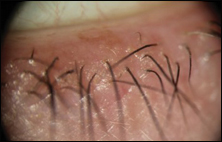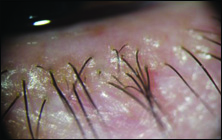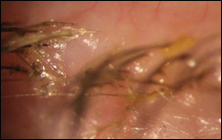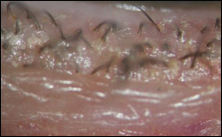Exfoliate the lid margin to prevent meibomian gland clogging
Biofilm thickens as we age, causing inflammation, migrating to the lid margin and invading adjacent follicles.
The clinical signs and symptoms of dry eye disease seem to be contradictory. Some patients report symptoms of pain and itching much worse than the clinical picture, while others report mild symptoms not commensurate with obvious signs of dry eye disease.
Further, a group of patients reports no symptoms when presented with severe clinical signs of dry eye disease (DED) – with slit lamp pictures indicating irrefutable witness to that fact.
DED can account for unexplained decrease in visual acuity; inaccuracy in IOL calculation and topographic measurement; less-than-optimal results with advanced technology IOLs, such as torics and bifocals; and inaccurate sequential optical coherence tomography and glaucoma progression testing.

Meibomianitis, or meibomian gland disease, is said to lead to evaporative DED and is recognized as a leading cause and telltale sign of altered tear osmolarity.
The solutions offered to alleviate/treat DED are multifaceted, ranging from simple to heroic measures.




James Rynerson, MD, attempted to determine how a patient ends up with MGD followed by altered homeostasis and hyperosmolarity, inflammation and cell apoptosis. His “bottom up” theory begins at the source of DED and follows its chronic and progressive course, and he offers a sensible solution.
The path of dry eye disease
Rynerson calls DED, or dry eye syndrome, by the more appropriate name of dry eye and blepharitis syndrome (DEBS).
The lid margin surface is colonized with Staphylococcus aureus and Staphylococcus epidermidis probably early in life, at 1 to 2 years of age, if not earlier. Bacteria secrete biofilm that serve as an anchor. This early in life, the biofilm is scant and not able to support large populations; therefore, there is no quorum-sensing and no virulence factors. The biofilm then spreads from the lid margin down into the follicles first, because of the space along the lash. This would be a thin biofilm not capable of leading to virulence factors.
As we age, the biofilm also ages and thickens, eventually causing inflammation, first within the follicles (easy access and small structure). While nesting and hiding, the bacteria secrete biofilm matrix (polysaccharide that binds water). They multiply and methodically invade other follicles. Polysaccharide is also a nutrient attracting Demodex infestation. Biofilm migrates to the lid margin and invades adjacent follicles.
At this point the bacteria proliferation plugs the duct and becomes virulent. Exotoxins and lipases engender folliculitis, an inflammation of the follicles. That, in turn, invades the meibomian glands. These glands are always second in terms of clinical inflammation, due to the narrow ductile that the biofilm must traverse and the sheer size of the gland.
Meibomianitis always follows folliculitis, according to Dr. Rynerson. The suffix “-itis” implies inflammation. Chronic inflammation/disease leads to atrophy and desensitization as observed in severe cases of the disease, with its lack of subjective symptoms decades later. Therefore, the solution is to start at the folliculitis stage, a stage where the patient is still sensitive and experiences symptoms of itching and burning.
Treatment
Microblepharoexfoliation (MBE) of the lid margin is used in-office to remove tenacious and noxious biofilm. The micro-sponge on the BlephEx (RySurg) spins 2,500 RPM along the lid margin. The treatment is repeated every 4 to 6 months depending on the severity of the case. This treatment eliminates the source of inflammation on the lid margin, but not within the meibomian glands or follicles that become affected when the disease/inflammation progress to advancing stages. Removal of the biofilm debulks bacterial density and ensuing virulence.
Once the meibomian glands are severely affected, additional measures are needed, such as LipiFlow (TearScience) to heat the meibum and express it. Nutraceuticals (omega-3s) can also be added to the mix. Antibiotics and steroids are sometimes necessary as adjunct therapy for severe cases. BlephEx lid hygiene is recommended as a maintenance.
It is better to attack the problem deep in the source, as is done in periodontal deep cleaning and treatment. It is important to keep in mind that folliculitis is forever present when preparing for LASIK or cataract extraction. A 2009 survey at George Washington University found that 37% to 47% of the population has blepharitis (Lemp 2009).
Another study (Kivanc et al.) showed that bacteria were not eliminated after patients were prepped for surgery with povidone iodine. After surgery, 16 eyes cultured positive with 34 isolates. Twenty-one isolates were weakly positive for biofilm, eight were moderately positive, and three were strongly positive after so-called sepsis treatment with strong povidone iodine.
Dr. Eric D. Donnenfeld stated in Ocular Surgery News briefly and eloquently: “The key to dry eye treatment is to treat the pathogenesis of the disease and not the sequelae. Don’t treat the symptoms – treat the disease process itself.”
Treat the folliculitis.

- References:
- Brinton M, et al. J Neural Eng. 2015;doi:10.1088/1741-2560/13/1/016006.
- Epitropoulos AT, et al. J Cataract Refract Surg. 2015;doi:10.1016/j.jcrs.2015.01.016.
- Hasson M. Ocular Surgery News U.S. Edition. New insights advance diagnosis, treatment of inflammatory dry eye – April 10, 2012.
- Kivanc SA, et al. J Wound Care. 2016;doi:http://dx.doi.org/10.12968/jowc.2016.25.1.12.
- Kojima T, et al., Am J Ophthalmol. 2005;doi:10.1016/j.ajo.2004.08.040.
- Lane SS, et al., Cornea. 2012;doi:10.1097/ICO.0b013e318239aaea.
- Lemp MA. The Ocular Surface. 2009;7(2):S1-S14.
- Lemp MA, et al. Am J Ophthalmol, 2011;doi:10.1016/j.ajo.2010.10.032.
- Lemp MA, et al. Cornea. 2012;doi:10.1097/ICO.0b013e318225415a.
- Leung CK, et al. Curr Opin Ophthalmol. 2014;doi:10.1097/ICU.0000000000000024.
- Nichols KK, et al. Invest Ophthalmol Vis Sci. 2011;doi:10.1167/iovs.10-6997a.
- Noble BA, et al. Br J Ophthalmol. 2004;doi:10.1136/bjo.2003.026211.
- Paulsen AJ, et al. Am J Ophthalmol. 2014;doi:10.1016/j.ajo.2013.12.023.
- Rynerson J. Dry eye decoded. Presented at: Nassau University Medical Center, Department of Ophthalmology; May 18, 2016.
- Trattler W, et al. Cataract and dry eye: Prospective Health Assessment of Cataract Patients’ Ocular Surface Study. Poster presented at ASCRS; March 2011; San Diego.
- Wenbo Hou W, et al. Invest Ophthalmol Vis Sci. 2012;doi:10.1167/iovs.11-9114.
- For more information:
- Joseph Hallak, OD, PhD, FAAO, is in private practice in Syosset, N.Y. He can be reached at drjhallak@aol.com.
- Acknowledgment: The author is indebted to Dr. James Rynerson for his kind incisive remarks and his permission to use the illustrations and figures appearing in this text.
Disclosure: Hallak reports no relevant financial disclosures.
